Burning Man

Burning Man

| Burning Man | |
|---|---|
| Begins | August 25, 2019 |
| Ends | September 2, 2019 |
| Frequency | Annual |
| Venue | Black Rock City |
| Location(s) | Black Rock Desert,Pershing County, Nevada, US |
| Coordinates | |
| Years active | 33 |
| Inaugurated | June 21, 1986 |
| Founders | Larry HarveyJohn LawJerry James |
| Attendance | 67,290 (2016)[1] |
| Website | |

Location in the western United States

Location in Nevada
Burning Man is an event held annually in the western United States at Black Rock City, a temporary city erected in the Black Rock Desert of northwest Nevada, approximately 100 miles (160 km) north-northeast of Reno. The late summer event is an experiment in community and art, influenced by ten main principles: radical inclusion, radical self-reliance, radical self-expression, communal effort, civic responsibility, gifting, decommodification, participation, immediacy, and leave no trace. The event takes its name from its culmination, the symbolic ritual burning of a large wooden effigy ("The Man") that traditionally occurs on the Saturday evening of the event.[2][3][4][5]
First held 33 years ago in 1986 on Baker Beach in San Francisco as a small function organized by Larry Harvey and Jerry James who built the first "Man", it has since been held annually, spanning the nine days leading up to and including Labor Day (the opening day is a Sunday, while the closing day is the first Monday in September). The 2019 event ran from August 25 to September 2.
At Burning Man, the community explores various forms of artistic self-expression, which are created to be enjoyed by all participants.
An anonymous attendee was once elaborated that "Burning Man is about 'why not' overwhelming 'why'".[6] Said NPR, "Once considered an underground gathering for bohemians and free spirits of all stripes, Burning Man has since evolved into a destination for social media influencers, celebrities and the Silicon Valley elite."[7] Participation is a key precept for the community; selfless giving of one's unique talents for the enjoyment of all is encouraged. Examples of creativity include experimental and interactive sculptures, buildings, performances and art cars, among other media. These contributions are inspired by a theme that is chosen annually by the organizers.
Burning Man is organized by the Burning Man Project, a non-profit organization that, in 2014, succeeded a for-profit limited liability company (Black Rock City, LLC) that was formed in 1997 to represent the event's organizers, and is now considered a subsidiary of the non-profit organization. In 2010, 51,515 people attended Burning Man.[8] Attendance in 2011 was capped at 50,000 participants and the event sold out on July 24;[9] the attendance rose to 70,000 in 2015.[10] The Burning Man Project endorses several smaller regional events inspired by the Burning Man principles both in the United States and internationally.
| Burning Man | |
|---|---|
| Begins | August 25, 2019 |
| Ends | September 2, 2019 |
| Frequency | Annual |
| Venue | Black Rock City |
| Location(s) | Black Rock Desert,Pershing County, Nevada, US |
| Coordinates | |
| Years active | 33 |
| Inaugurated | June 21, 1986 |
| Founders | Larry HarveyJohn LawJerry James |
| Attendance | 67,290 (2016)[1] |
| Website | |
History
1986 to 1989

Two of the founders of Burning Man: John Law (left) and Michael Mikel
Burning Man began as a bonfire ritual on the summer solstice in 1986 when Larry Harvey, Jerry James and a few friends met on Baker Beach in San Francisco[11][12] and burned an 8 feet (2.4 m) tall wooden man as well as a smaller wooden dog. Harvey has described his inspiration for burning these effigies as a spontaneous act of "radical self-expression".[13] Sculptor Mary Grauberger, a friend of Harvey's girlfriend Janet Lohr, held solstice bonfire gatherings on Baker Beach for several years prior to 1986, some of which Harvey attended. When Grauberger stopped organizing it, Harvey "picked up the torch", and ran with it.[13] He and Jerry James built the first wooden effigy on the afternoon of June 21, 1986, cobbled together using scrap wood, to be torched later that evening. In 1987, the effigy grew to 15 feet (4.6 m) tall, and by 1988, it had grown to 30 feet (9.1 m).[14][15]
By 1988, Larry Harvey formally named the summer solstice ritual "Burning Man", by titling flyers for the happening as such; to ward off references such as "wicker man", referring to the practice of burning live sacrifices in wicker cages.
Harvey has stated that he had not seen the 1973 cult filmThe Wicker Man until many years after and that it did not inspire the action.[14][16]
1990 to 1996
In 1990, a separate event was planned by Kevin Evans and John Law on the remote and largely unknown dry lake or playa known as Black Rock Desert, about 110 miles north of Reno, Nevada.[17] Evans conceived it as a dadaist temporary autonomous zone with sculpture to be burned and situationist performance art. He asked John Law, who also had experience on the dry lake and was a defining founder of Cacophony Society, to take on central organizing functions. In the Cacophony Society's newsletter, it was announced as Zone No. 4, A Bad Day at Black Rock (inspired by the 1955 film of the same name).
Meanwhile, the beach burn was interrupted by the park police for not having a permit.
After striking a deal to raze the Man but not to burn it, event organizers disassembled the effigy and returned it to the vacant lot where it had been built.
Shortly thereafter, the legs and torso of the Man were chain-sawed and the pieces removed when the lot was unexpectedly leased as a parking lot.
The effigy was reconstructed, led by Dan Miller, Harvey's then-housemate of many years, just in time to take it to Zone Trip No.
4.[18]
Michael Mikel, another active Cacophonist, realized that a group unfamiliar with the environment of the dry lake would be helped by knowledgeable persons to ensure they did not get lost in the deep dry lake and risk dehydration and death.
He took the name Danger Ranger, and created the Black Rock Rangers.
Thus Black Rock City began as a fellowship, organized by Law and Mikel, based on Evans' idea, along with Harvey and James' symbolic man.
Drawing on experience in the sign business and with light sculpture, John Law prepared custom neon tubes for the Man in 1991 so it could be seen as a beacon at night.
In its first years, the community grew by word of mouth alone, all were considered participants by virtue of surviving in the desolate surreal trackless plain of the Black Rock Desert. There were no paid or scheduled performers or artists, no separation between art-space and living-space, no rules other than "Don't interfere with anyone else's immediate experience" and "no guns in central camp."
1991 marked the first year that the event had a legal permit, through the BLM (the Bureau of Land Management).[19] 1991 was also the year that art model and fire dancer (and later Burning Man's first art director) Crimson Rose attended the event.[20] 1992 saw the birth of a smaller, intensive (about 20 participants the first year; about 100 in years two and three) near-by event named "Desert Siteworks", conceived and directed by William Binzen and co-produced (in 1993 and '94) with Judy West.[21] The annual, several weeks-long event, was held over summer Solstice at various fertile hot springs surrounding the desert. Participants built art and participated in self-directed performances. Some key organizers of Burning Man were also part of Desert Siteworks (John Law, Michael Mikel) and William Binzen was a friend of Larry Harvey. Hence, the two events saw lots of cross-pollination of ideas and participants.[22] The Desert Siteworks project ran for three years (1992–1994). 1996 was the first year a formal partnership was created to own the name "Burning Man" and was also the last year that the event was held in the middle of the Black Rock Desert with no fence around it.
Before the event opened to the public in 1996, a worker named Michael Furey was killed in a motorcycle crash[23] while riding from Gerlach, Nevada, to the Burning Man camp in the Black Rock Desert. Harvey insisted that the death had not occurred at Burning Man, since the gates were not yet open. Another couple were run over in their tent by an art car driving to "rave camp", which was at that time distant from the main camp. After the 1996 event, co-founder and partner John Law broke with Burning Man and publicly said the event should not continue.
1997 to present
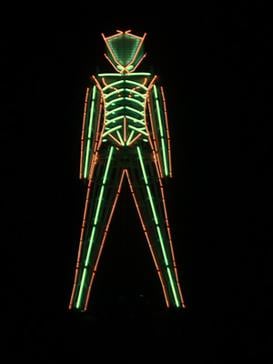
The neon-tubed Man at the 1999 event
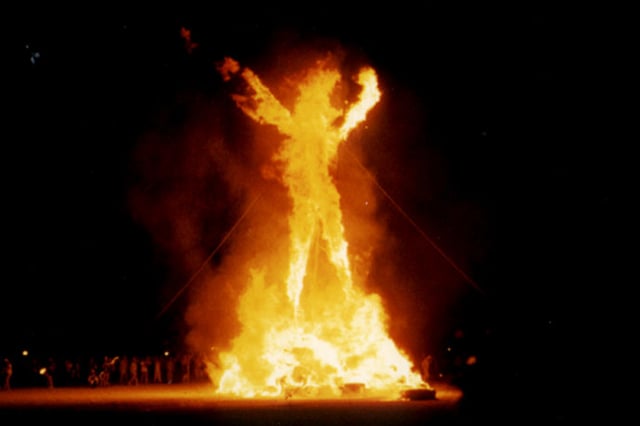
Light matter, Burning Man 2004
1997 marked another major pivotal year for the event.
By 1996, the event had grown to 8,000 attendees and unrestricted driving on the open playa was becoming a major safety hazard.
To implement a ban on driving and re-create the event as a pedestrian/bicycle/art-car-only event, it was decided to move to private gated property.
Fly Ranch, with the smaller adjoining Hualapai dry lake-bed, just west of the Black Rock desert, was chosen.
This moved Burning Man from Pershing County/federal BLM land into the jurisdiction of Washoe County, which brought a protracted list of permit requirements.[13]
To comply with the new requirements and to manage the increased liability load, the organizers formed Black Rock City, LLC. Will Roger Peterson and Flynn Mauthe created the Department of Public Works (DPW) to build the "city" grid layout (a requirement so that emergency vehicles could be directed to an "address") designed by Rod Garrett, an architect. Rod continued as the city designer until his death, in 2011, at the age of 76. He is also credited with the design of all of the man bases from 2001 through 2012, the center camp café and first camp.[25] With the success of the driving ban, having no vehicular incidents, 1998 saw a return to the Black Rock desert, along with a temporary perimeter fence. The event has remained there since.
As the population of Black Rock City grew, further rules were established in relation to its survival.
Some critics of the event cite the addition of these rules as impinging on the original freedoms, altering the experience unacceptably, while others find the increased level of activity more than balances out the changes.
Another notable restriction to attendees is the 9.2-mile (14.8 km) long[32] temporary plastic fence that surrounds the event and defines the pentagon of land used by the event on the southern edge of the Black Rock dry lake.[33] This 4-foot (1.2-meter) high barrier is known as the "trash fence" because its initial use was to catch wind-blown debris that might escape from campsites during the event. Since 2002, the area beyond this fence has not been accessible to Burning Man participants during the week of the event.[34]
One visitor who was accidentally burned at the 2005 event unsuccessfully sued Black Rock City, LLC in San Francisco County Superior Court. On June 30, 2009, the California Court of Appeal for the First District upheld the trial court's grant of summary judgment to Black Rock City, LLC on the basis that visitors who deliberately walk towards the Burning Man after it is lit assume the risk of getting burned by such an obviously hazardous object.[35]
On September 3, 2017[36] a 41-year-old man, Aaron Joel Mitchell, fought his way past a safety cordon of volunteers and firefighters and threw himself into the flames of the primary Burning Man effigy.
Mitchell died the next day due to cardiac arrest, bodily shock and third-degree burns to 98% of his body.
While a reputable member of the DPW claims this was the result of a dare to run through the flames, his death was ruled a suicide.[37][38][39][40]
Transition to a non-profit organization
In April 2011, Larry Harvey announced that the LLC was beginning a three-year process to transfer ownership and control of the event over to a new non-profit organization called the "Burning Man Project."
The move towards becoming a non-profit organization was the result of "bitter infighting" between members of the board.
At one point it looked like all of the board members were going to hire lawyers.
Corporate appraisers were brought in to determine how much the company was worth, which Larry Harvey found "abhorrent" and against all of the values that Burning Man stood for.[41]
An earlier agreement stated that each member of the LLC would only receive "sole compensation for many years of service, a golden parachute of $20,000."
But the members now consented to an arrangement whereby each member of the LLC would receive an undisclosed sum prior to the transfer of their ownership rights to the Burning Man Project.
Marian Goodell, board member and head of communications, addressed concerns about the lack of transparency with this statement: "When you're in the middle of a storm, if you're going to explain all of how you got there, and how you're going to get out, it often sets more panic among the survivors than if you just sail the boat out of the darkness."[42]
It was announced in March 2014 via the official Burning Man Blog that the non-profit transition was complete.[43] Under the new non-profit structure Black Rock City LLC, the longtime for-profit responsible for the event, would be a subsidiary of the non-profit Burning Man Project.
Although unmentioned in the initial announcement, the Terms and Conditions for ticket buyers were changed to reflect an alteration in the structure of the business.
Under the new terms it was made known that a new LLC was created, Decommodification LLC, which in the new non-profit business structure, owns all of the intellectual property associated with the Burning Man brand, including ownership over logos and trademarks, and will be responsible for enforcement thereof.[44] The non-profit Burning Man Project licenses usage of all intellectual property associated with Burning Man from Decommodification LLC.
After questions were raised by the community about this new LLC within the comment section on the original non-profit announcement Larry Harvey confirmed that he and the other founders were the sole owners of this new LLC.
Timeline of the event
The statistics below illustrate the growth in attendance of the Burning Man event, from a few handfuls of people to more than 70,000 in 2015, as well as other facts and figures.[45] Burning Man 2006 was covered extensively for television for the first time by subscription television channel Current TV which handed out cameras to participants and broadcast daily updates via satellite from the dry lake. "TV Free Burning Man" also provided TV viewers an hour-long live feed of the Burn and was shown without commercial sponsorship. TV Free returned in 2007 and 2008; the 2007 coverage was nominated for a news Emmy Award.[46]
The height of the Burning Man effigy has remained close to 40 feet (12 meters) tall between 1989 and 2013.
During those years changes in the height and structure of the base account for the differing heights of the overall structures.
In 2014 the configuration and height of the Man itself changed, and Burners were presented with a taller, more robust figure.
For 2016, 2017 & 2018 the Man itself returned to its 40-foot configuration.
| Year | Height from groundto top of Man | Location | Participants | BLM population cap[47][48] | Admission/Ticket(s) Cost | Theme | Number of Theme Camps / Placed Art | Notes |
|---|---|---|---|---|---|---|---|---|
| 1986 | 8 ft (2.4 m) | Baker Beach | 35 | Not on BLM Land. | Free | None | None | Larry Harvey & Jerry James build & burn wooden man on Baker Beach on the summer solstice, following a ritual bonfire tradition begun by Mary Grauberger. |
| 1987 | 15 ft (4.6 m) | Baker Beach | 80 | Not on BLM Land. | Free | None | None | |
| 1988 | 30 ft (9.1 m) | Baker Beach | 200 | Not on BLM Land. | Free | None | None | |
| 1989 | 40 ft (12 m) | Baker Beach | 300 | Not on BLM Land. | Free | None | None | First listing of Burning Man in the San Francisco Cacophony Society newsletter, "Rough Draft" under "sounds like cacophony." |
| 1990 | 40 ft (12 m) | Baker Beach &Black Rock Desert |
| None | Free | None | None | Figure erected at Baker Beach on Summer Solstice (June 21) but not burned.Man is invited to San Francisco Cacophony Zone Trip No. 4 on Labor Day weekend in the Black Rock Desert, Nevada. |
| 1991 | 40 ft (12 m) | Black Rock Desert | 250 | $15 | None | None | First year of neon on the man. | |
| 1992 | 40 ft (12 m) | Black Rock Desert | 600 | $25 | None |
| First year amplified music appeared at Burning Man.Craig Ellenwood and TerboTed set up a camp, approved by Larry Harvey one mile from center camp and launched the first EDM camp.[49][50][51] | |
| 1993 | 40 ft (12 m) | Black Rock Desert | 1,000 | $25–$40 | None |
| "Christmas Camp" becomes the first theme camp, with its two members dressing up as Santa and giving out fruitcake and eggnog. | |
| 1994 | 40 ft (12 m) | Black Rock Desert | 2,000 | $30 | None |
| First year of wooden spires and lamplighting. | |
| 1995 | 40 ft (12 m) | Black Rock Desert | 4,000 | $35 | None |
| Unofficial theme was "Good and Evil". | |
| 1996 | 48 ft (15 m) | Black Rock Desert | 8,000 | $35 | Inferno |
| Theme featuring Dante's Inferno/HELCO (a satire on corporate takeovers).First year the man is elevated on a straw bale pyramid and guns banned in central camp.First fatality in motorcycle collision.3 people seriously injured in a tent run over by a car.[52]10 of 16 BLM stipulations violated, putting BM on probationary status for next year.An injury claim drives liability coverage up by a factor of 6.Featured in an article inWired magazine.[53] | |
| 1997 | 50 ft (15 m) | Hualapai Playa | 10,000 | $65 | Fertility: The Living Land |
| The BM org.forms management structure, the DPW to meet strict permit requirements newly imposed.First year the city has grid streets and driving banned.Washoe County officials impounded gate receipts to ensure payment after the fire and protection fees along with more than 100 new fire and safety conditions are imposed before the event.[54] | |
| 1998 | 52 ft (16 m) | Black Rock Desert | 15,000 | $65–$100 | Nebulous Entity |
| Burning Man returned to the Black Rock Desert although much closer toGerlachthan before.The "Nebulous Entity" was Harvey's satirical concept of alien beings who thrive on information – who consume it but do not understand it. | |
| 1999 | 54 ft (16 m) | Black Rock Desert | 23,000 | $65–$100 | Wheel of Time |
| Listed in the AAA's RV guide under "Great Destinations." | |
| 2000 | 54 ft (16 m) | Black Rock Desert | 25,400 | $95–$200 | The Body |
| First active law enforcement activity, 60Bureau of Land Management(BLM) and police arrests and citations.Most are for minor drug charges following surveillance and searches. | |
| 2001 | 70 ft (21 m) | Black Rock Desert | 25,659 | $200 | Seven Ages |
| SeeSeven Ages of Man.Over 100 BLM citations and 5 arrests. | |
| 2002 | 80 ft (24 m) | Black Rock Desert | 28,979 | $135–$200 | The Floating World |
| First year forFAAapproved airport.135 BLM citations and 4 Sheriff citations. | |
| 2003 | 79 ft (24 m) | Black Rock Desert | 30,586 | $145–$225 | Beyond Belief |
| Dogs are banned for the first time.177 BLM citations, 9 police citations, 10 arrests and 1 fatality.[55] | |
| 2004 | 80 ft (24 m) | Black Rock Desert | 35,664 | The Vault of Heaven |
| 218 BLM citations, some issued from decoy 'art car'.Camps giving away alcohol subjected to state law compliance examinations and 1 arrest.Pershing County Sheriff's office: 27 cases, 4 arrests, 2 citations.Nevada Highway Patrol: 2 DUI arrests, 217 citations, and 246 warnings were issued.Malcolm in the Middle used burning man in one of their episodes. | ||
| 2005 | 72 ft (22 m) | Black Rock Desert | 35,567 | $145–$250 | Psyche: The Conscious,Subconscious & Unconscious |
| The Man, perched atop a "fun house" maze, can be turned by participants, confusing those at a distance who use it to navigate.Dream related art work.218 BLM citations, 6 arrests and 1 fatality. | |
| 2006 | 72 ft (22 m) | Black Rock Desert | 38,989 |
| $185–$280 | Hope and Fear: The Future |
| The Man goes up and down reflecting a hope/fear meter.Voting stations were set up around the playa, allowing residents to cast a Hopeful or Fearful vote for the future of Man.If the vote was hopeful he would burn with his hands in the air- not- hands down.They voted hopeful- and his arms were raised till the end.155 BLM citations and 1 arrest.Pershing County Sheriff's office: 1 citation and 7 arrests.Nevada Highway Patrol: 234 citations, 17 arrests, and 213 warnings. |
| 2007 | 65 ft (20 m) | Black Rock Desert | 47,097[57] |
| $195–$280 | The Green Man |
| The Man was prematurely set on fire around 2:58 am, Tuesday August 28, during full Lunar eclipse.A repeat Burning Man prankster, Paul Addis, was arrested and charged with arson,[58]and the Man was rebuilt for regular Saturday burn.Addis pleaded guilty in May 2008 to one felony count of injury to property, was sentenced to up to four years in Nevada state prison, and was ordered to pay $30,000 in restitution.[59]331 BLM citations. |
| 2008 | 100 ft (30 m) | Black Rock Desert | 49,599[60] |
| $210–$295 | American Dream |
| First year that tickets are not sold at the gate.[61]The size and layout of the city is enlarged to accommodate a larger central playa and a longer Esplanade.Because of excessively high winds and whiteout conditions on Saturday, the burning of the Man was delayed for over an hour and a half and the fire conclave was canceled.Many longtime contributors opted out allegedly due to the chosen theme ("The American Dream"), jailing of dissenter Addis, and the founders' rift.The perimeter of BRC extended to 9 miles.The BLM made 6 arrests and issued 129 citations. |
| 2009 | 66 ft (20 m) | Black Rock Desert | 43,558[62] |
| $210–$360 | Evolution: A Tangled Bank |
| Tickets sold at the gate once again.As the result of some criticism, the size and layout of the city was returned to roughly the same as the 2007 event.The BLM officials said that as of noon Saturday, 41,059 people were at Burning Man, and the crowd peaked at 43,435 at noon Friday, a noted decline after years of steady attendance growth, due mainly to the 2008stock market crash.BLM issued 287 citations and 9 arrests. |
| 2010 | 100 ft (30 m) | Black Rock Desert | 51,525[63] |
| $210–$360 | Metropolis – Life of Cities[64] |
| Attendance over 50,000 mark, for first time.The gate opened early, at 6 pm Sunday, for first time.Coincided with the inaugural Black Rock City Film Festival.BLM issued 293 citations and 8 arrests. |
| 2011 | 104 ft (32 m) | Black Rock Desert | 53,963[65] | 50,000[66] | $210–$360 | Rites of Passage[67] |
| According to Black Rock LLC, 27,000 tickets (all discounted tiers) were sold by midday the day following the opening of ticket sales.[68]For the first time in Burning Man history, tickets sold out before the event on July 24, 2011.[68] |
| 2012 | 40 ft (12 m) on a 50 ft (15 m) base[69] | Black Rock Desert | 56,149[70] | 60,900[71] | $240–$420 | Fertility 2.0[72] |
| Due to the sellout of the event in 2011, the BMOrg opted for a complex multi-round, random selection system of ticket sales with a separate low income program.On January 27, BMOrg announced that the number of tickets requested in the Main Sale was around 120,000 vs the 40,000 that were available.In consequence a significant number of registrants would not be awarded tickets in the Main Sale.The Main Sale was originally planned to be followed by a secondary open sale of 10,000 tickets.However, as the huge demand from the Main Sale left many veteran burners and theme camps without tickets, BMOrg opted for a "directed ticket distribution" instead, i.e., "manually redirect them to some of the vital groups and collaborations that make up Black Rock City" rather than an open sale. |
| 2013 | 40 ft (12 m) on a 55 ft (17 m) base | Black Rock Desert | 69,613[73] | 68,000[74] | $380 | Cargo Cult[75] |
| The year's theme was based onJohn FrumandCargo Cults.[76]Ticket tiers were eliminated and a flat rate price structure was adopted (except for low-income ticket program).[77] |
| 2014 | 105 ft (32 m) | Black Rock Desert | 65,922[10] | 68,000[47] |
| Caravansary[78] |
| This year, the Burning Man Traffic Mitigation Plan went into effect.All vehicles entering Black Rock City needed a $40 vehicle pass.Only 35,000 passes were available.[79]A woman is killed in a vehicle collision.[80] |
| 2015 | 60 ft (18 m) | Black Rock Desert | 67,564[81] | 70,000[82] |
| Carnival of Mirrors[84] |
| First time in nearly 10 years that the Man base is on the ground (vs a raised base).Only 27,000 vehicle passes were made available this year.[83] |
| 2016 | 43 ft (13 m) | Black Rock Desert | 67,290[1] | 70,000[85] |
| DaVinci's Workshop[87] |
| Tying in with the 2016 theme – the works ofLeonardo da Vinci, the Man was a large-scale interpretation of theVitruvian Manon a circular frame; contained within its base was a wheel and gear system that was to allow groups of visitors to manually rotate the Man.[88]The gear system was damaged during setup, however, and was not functional during the event.[89] |
| 2017 | 42 ft (13 m) | Black Rock Desert | 69,493[90] | 70,000[91] |
| Radical Ritual[93] |
| Aaron Joel Mitchell died after running through the security cordon into the flaming effigy.[94] |
| 2018 | Data not yet public. | Black Rock Desert | Data not yet public. | 70,000[95] |
| I, Robot[97] |
| Due to ticket overselling, the population of Black Rock City exceeded the 70,000 participant limit, and on Thursday of event week theBLMrequested that the gate be closed.New participants were only let in once another had left.[99] |
| 2019 | Data not yet public. | Black Rock Desert | Data not yet public. | 80,000[48][100] |
| Metamorphoses[102] | 2019 placement data not yet public. | Starting in 2019, the population cap now includes BRC Staff and volunteers in addition to paid participants, however the maximum population limit remains the same as in 2018[48] |
Principles
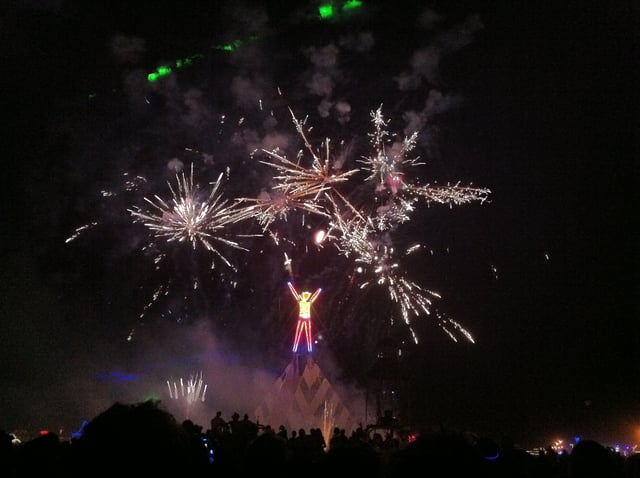
The effigy with fireworks before being burned in 2011
The Burning Man event and its affiliated communities are guided by 10 principles that are meant to evoke the cultural ethos that has emerged from the event.
They were originally written by Larry Harvey in 2004[105] as guidelines for regional organizing, then later became a universal criterion of the general culture of the multifaceted movement.
They are:[106]
radical inclusion
gifting
decommodification
radical self-reliance
radical self-expression
communal effort
civic responsibility
leaving no trace
participation
immediacy
The descriptions in quotes are the actual text:
Radical Inclusion
"Anyone may be a part of Burning Man.
We welcome and respect the stranger.
No prerequisites exist for participation in our community."
This was written with a broad stroke for general organizing, meaning anyone is welcome to the Burning Man culture.
Prerequisites for the Burning Man[106] event are; participants are expected to provide for their own basic needs, follow the guidelines stated in the annually updated event "survival guide", and purchase a ticket to get in.[107]
Gifting
"Burning Man is devoted to acts of gift giving.
The value of a gift is unconditional.
Gifting does not contemplate a return or an exchange for something of equal value."
Instead of cash, participants at the Burning Man event in the Black Rock Desert are encouraged to rely on a gift economy, a sort of potlatch. In the earliest days of the event, an underground barter economy also existed, in which burners exchanged "favors" with each other. While this was originally supported by the Burning Man organization, this is now largely discouraged. Instead, burners are encouraged to give gifts to one another unconditionally.
Decommodification
"In order to preserve the spirit of gifting, our community seeks to create social environments that are unmediated by commercial sponsorships, transactions, or advertising.
We stand ready to protect our culture from such exploitation.
We resist the substitution of consumption for participatory experience."
No cash transactions are permitted between attendees of the Burning Man event in the Black Rock Desert.
Cash can be used for a select few charity, fuel, and sanitation vendors as follows: [108]
Café beverages such as coffee, chai, lemonade, etc., which are sold at Center Camp Café, operated by the organizers of the event.[109]
Ice sales benefit the local Gerlach-Empire school system.[110]
Tickets for the shuttle bus to the nearest Nevada communities of Gerlach and Empire which is operated by a contractor not participating in the event: Green Tortoise.[108]
A re-entry wristband, which allows a person to leave and re-enter the event and may be purchased at the gate upon exit.[112]
An airport use fee, payable at the airport upon first entry.[113]
Diesel and biodiesel sold by third-party contractors.
RV dump service and camp graywater disposal service.[114]
Private portable toilets and servicing, which can be arranged with the official contractor.
Radical Self-Reliance
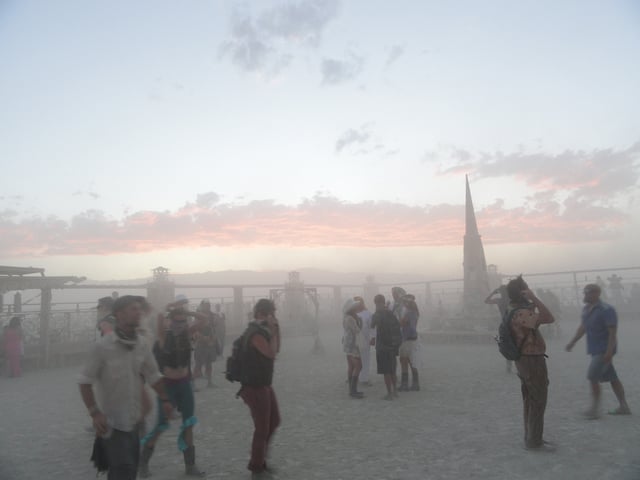
Dust storms are common at Burning Man, so many come prepared with appropriate provisions, such as goggles and masks to reduce dust inhalation.
"Burning Man encourages the individual to discover, exercise and rely on his or her inner resources."
The event's harsh environment and remote location requires participants to be responsible for their own subsistence.
Since the LLC forbids most commerce, participants must be prepared and bring all their own supplies with the exception of the items stated in Decommodification.[115]
Radical Self-Expression

Trojan Horse Pull – Burning Man 2011
"Radical self-expression arises from the unique gifts of the individual.
No one other than the individual or a collaborating group can determine its content.
It is offered as a gift to others.
In this spirit, the giver should respect the rights and liberties of the recipient."
Participants at the Burning Man event in the Black Rock Desert are encouraged to express themselves in a number of ways through various art forms and projects.
The event is clothing-optional and public nudity is common, though not practiced by the majority.[116][117][118]
Communal Effort
"Our community values creative cooperation and collaboration.
We strive to produce, promote and protect social networks, public spaces, works of art, and methods of communication that support such interaction."
Participants at the Burning Man event in the Black Rock Desert are encouraged to work with and help fellow participants.[119]
Civic Responsibility
"We value civil society.
Community members who organize events should assume responsibility for public welfare and endeavor to communicate civic responsibilities to participants.
They must also assume responsibility for conducting events in accordance with local, state and federal laws."
Leave No Trace
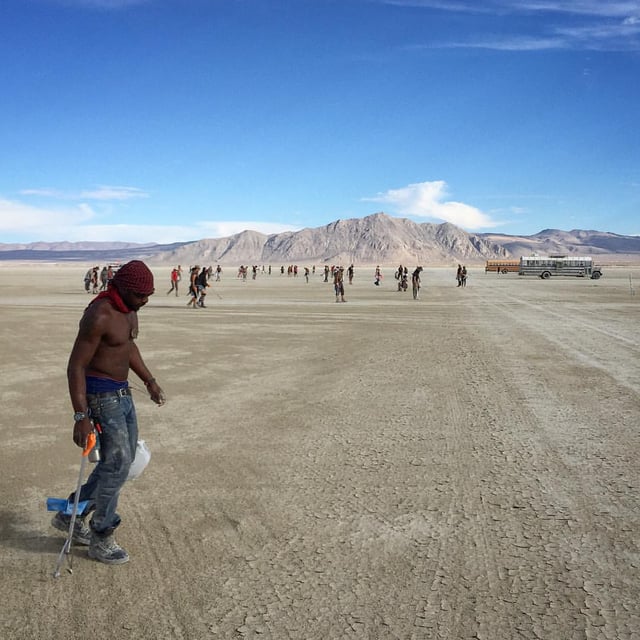
Burning Man Playa Restoration 2015 – attendees carry MOOP (matter out of place) sticks and buckets and walk to pick up discarded materials, as part of the 'leave no trace' policy.
"Our community respects the environment.
We are committed to leaving no physical trace of our activities wherever we gather.
We clean up after ourselves and endeavor, whenever possible, to leave such places in a better state than when we found them."
Participation
"Our community is committed to a radically participatory ethic.
We believe that transformative change, whether in the individual or in society, can occur only through the medium of deeply personal participation.
We achieve being through doing.
Everyone is invited to work.
Everyone is invited to play.
We make the world real through actions that open the heart."
People are encouraged to participate, rather than observe.
Immediacy
"Immediate experience is, in many ways, the most important touchstone of value in our culture.
We seek to overcome barriers that stand between us and a recognition of our inner selves, the reality of those around us, participation in society, and contact with a natural world exceeding human powers.
No idea can substitute for this experience."
Themes
Every year since 1995 has had a theme that has guided the ticket artwork, events and artwork on Playa.
Prior to 2019, the theme was decided by Larry Harvey and announced in essay form to steer the imagery and participation.[120] Larry Harvey died in April 2018, leaving the Burning Man organization responsible to name subsequent themes.
The Temple
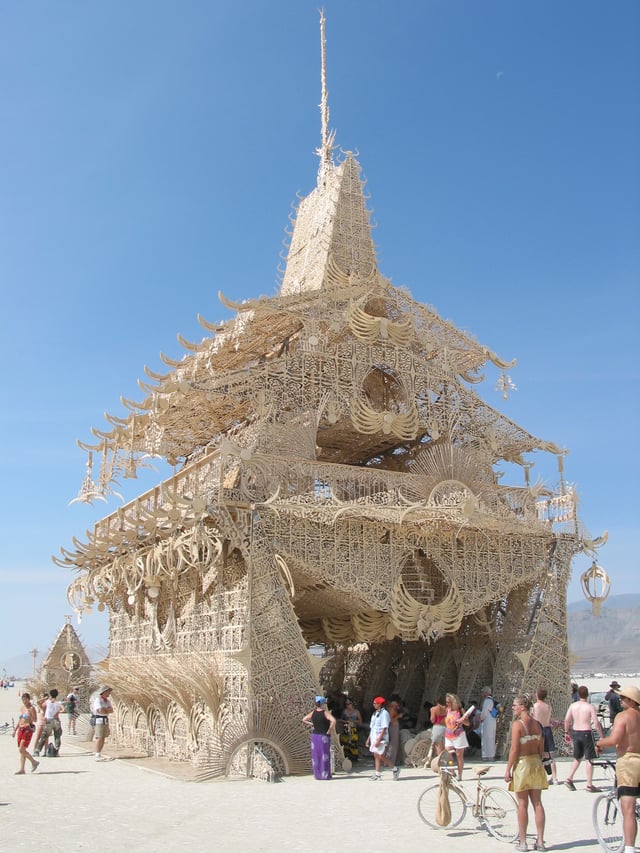
2002 Temple Of Joy
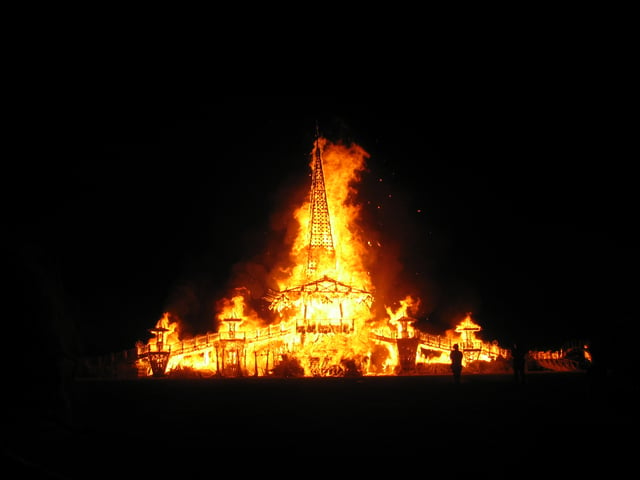
2004 Temple Of Stars
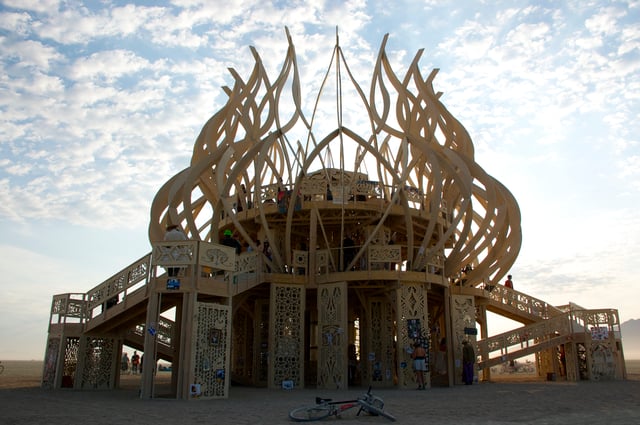
2009 "Fire of Fires" Temple
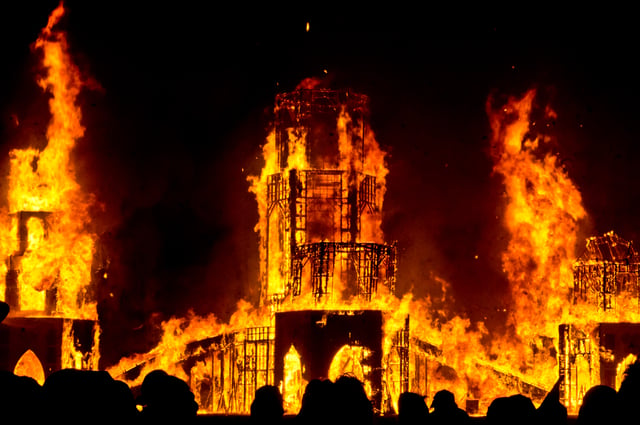
2011 Temple Of Transition
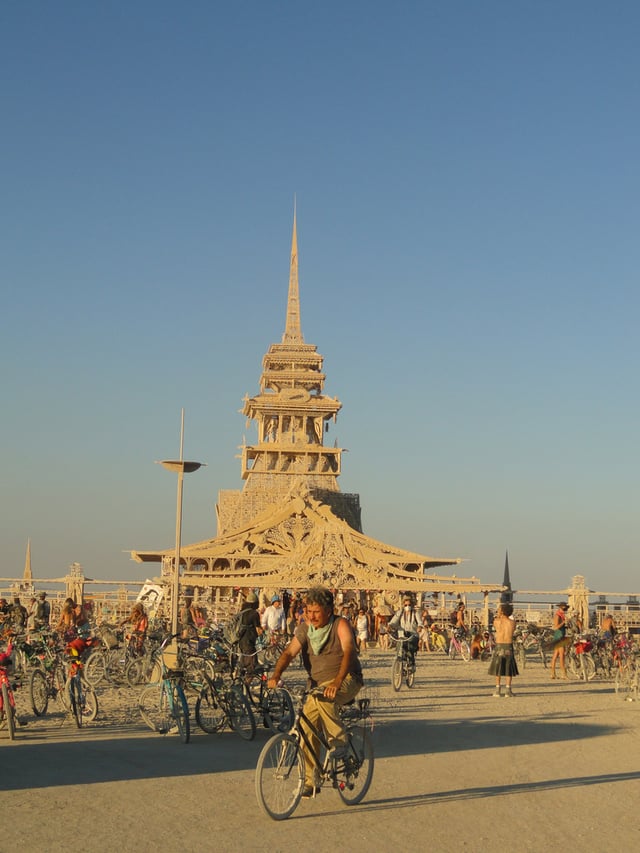
2012 Temple Of Juno
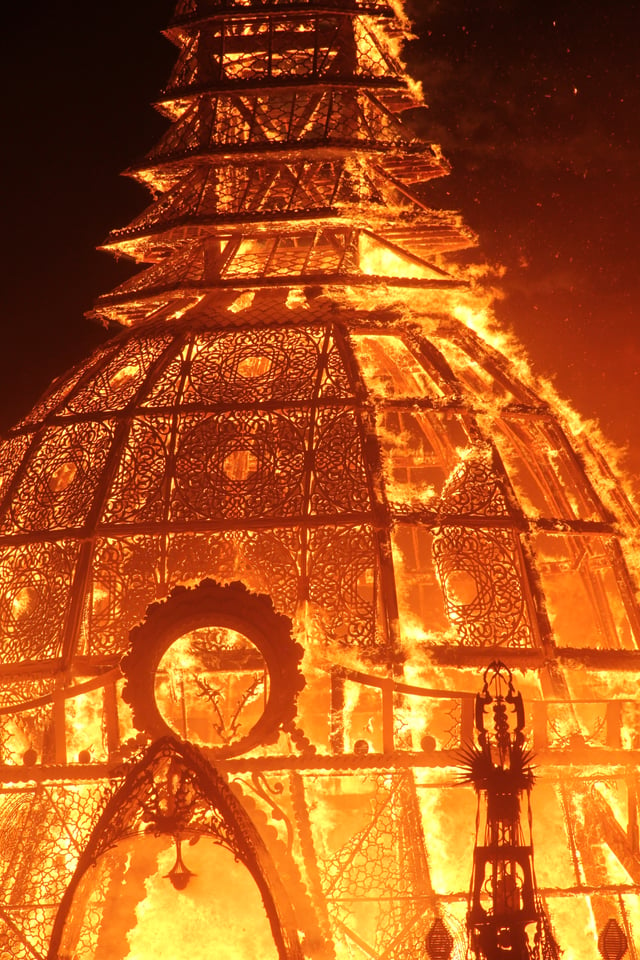
2014 Temple Of Grace
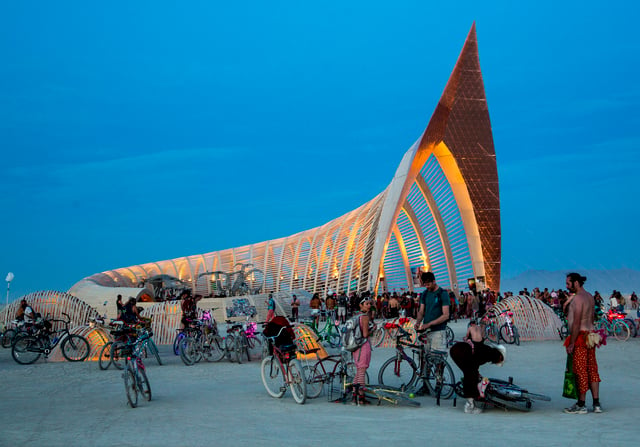
2015 Temple of Promise
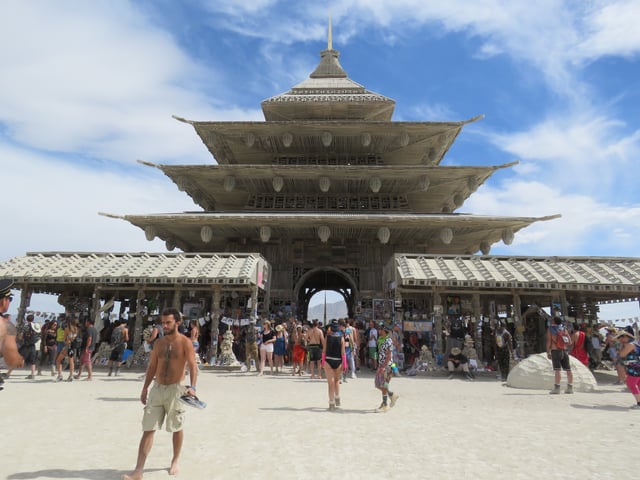
2016 Temple (with No Name)
The burning of a temple, as well as the Man, has become a traditional activity at the event.
It takes place the evening after the burning of the Man.
Sculptor David Best's temple projects were ritually burned from 2000 to 2004.[144] The tradition of participants inscribing the surfaces of the piece with personal messages has continued through all of the iterations of the temple.
| Year | Temple name | Detail |
|---|---|---|
| 2000 | The Temple of the Mind | |
| 2001 | The Temple of Tears | |
| 2002 | The Temple of Joy | |
| 2003 | The Temple of Honor | |
| 2004 | The Temple of Stars | |
| 2005 | The Temple of Dreams | David Best stepped aside to allow for another artist,Mark Grieve, to build his own interpretation of a Temple.[145]Grieve's temples were seen in both 2005 and 2006. |
| 2006 | The Temple of Hope | |
| 2007 | The Temple of Forgiveness | David Best took over the Temple building duties for what he thought would be one last time.Best stated that after 2007, it was time to hand the Temple over to the community. |
| 2008 | Basura Sagrada | The "Basura Sagrada" (Spanish for "sacred trash") was a collaboration of Shrine and Tucker Teutsch 3.0, built with the extensive help of their friends and the greater Burning Man community.[146] |
| 2009 | Fire of Fires | This Temple was built in Austin, Texas.[147] |
| 2010 | The Temple of Flux | This Temple was designed and orchestrated by artists Rebecca Anders, Jess Hobbs and Peter (pk.) Kimelman who formed the Flux Foundation.This group was notable for drawing from a broad section of the Burning Man community, including the large-scale sound camps and other existing BM art groups.The Flux Foundation has since continued to make large-scale public art outside Burning Man.[148]The Temple of Flux broke from tradition and was highly abstract in nature, appearing as a series of landforms with canyon and cave-like spaces.[149] |
| 2011 | The Temple of Transition | This was the first Temple built in Reno, Nevada.The International Arts Megacrew, helmed by Chris "Kiwi" Hankins, Diarmaid "Irish" Horkan and Ian "Beave" Beaverstock returned to a more traditional style.The Temple of Transition[150]took the form of a 120-foot tiered, hexagonal central tower, surrounded by five 58-foot tiered, hexagonal towers.The towers were vaulted and lofty, cut with a profusion of gothic style arches. |
| 2012 | The Temple of Juno | With the 2012 Temple came the return of David Best.[151]The Temple of Juno incorporated a large central tower with central altar space, sitting within a 150' x 150' walled courtyard lined with benches, accessed from four entrances.Intricately cut wooden panels and detailed shapes covered the courtyard walls as well as the interior space and altars. |
| 2013 | The Temple of Whollyness | This temple was created by The Otic Oasis team, led by architect and artist Gregg Fleishman,[152]Terry Lightning "Clearwater III" Gross, and Melissa "Syn" Barron.[153]This was the first Temple built without nails, bolts, adhesives, or fasteners of any kind.This Temple incorporated a massive 17-ton black basalt Inuksuk sculpture created by artist, James LaFemina to act as the central altar.[154]Conceptual artist and composer, Aaron 'Taylor' Kuffner, who debuted at Burning Man with the 2011 Temple of Transition, returned to contribute musical elements with a different execution of the Gamelatron. |
| 2014 | The Temple of Grace | Following the sudden withdrawal of chosen 2014 Temple builder Ross Asselstine, who was to build the Temple of Descendants, David Best came out of retirement a third time to build his eighth Temple.The Temple of Grace was intended to be a spiritual and sacred space for memorials, reflection, celebration, and to commemorate life transitions.[155]The structure incorporated a central interior dome within a graceful curved body made of wood and steel.Again, it had intricately cut wooden panels for the exterior and interior skin.Eight altars surrounded the temple inside a low-walled courtyard, creating a large exterior grounds for the community. |
| 2015 | The Temple of Promise[156] | This temple was created by Dreamers Guild and built primarily in Alameda, California.[157]The temple welcomed participants through an archway soaring 97 feet (30 m) overhead.As the path continued to curve, it opened into the contemplative altar and the heart of the Temple: a grove of three sculpted trees.The branches were initially bare, and participants wrote messages on long strips of cloth and attached them to the trees, creating the gentle shade ofweeping willows, increasing as the week progressed. |
| 2016 | The Temple | David Best came out of retirement yet again to build a pagoda style temple.This year the wooden pieces were cut by hand without the use of aCNCmachine.[158] |
| 2017 | The Temple | Designed by Steven Brummond, Marisha Farnsworth and Mark Sinclair (who acted as leads on prior David Best temples); two are architects and one is a structural engineer.It stood 80 feet (24 m) tall and 120 feet (37 m) across.They milled the lumber themselves, and most of the build was at a sawmill in Sonora, California.[159] |
| 2018 | Galaxia[160] | Designed by architect Arthur Mamou-Mani and built in two locations; Reno, Nevada, and Oakland, California.[161]Galaxia was shaped by 20 timber trusses converging as a spiral towards one point in the sky.The triangular trusses formed different paths towards a central space holding a series of giant 3D printed mandalas at the center.The timber modules start large enough to hold small alcoves in which people could interact with the structure in peace.As participants walked through the path, the timber modules lifted up and became thinner towards the sky as they reached the central mandala.[162] |
| 2019 | The Temple of Direction | Designed by Geordie Van Der Bosch, was a 180-foot-long, 37-foot-wide, 36-foot-high structure, with four entrances facing the four cardinal directions of Black Rock City, 12, 3, 6, and 9 o’clock.[163]The Temple of Direction is a linear space, capturing the elegance and austerity of thetorii gatesat theFushimi Inari Shrinein Japan, where the artist has previously lived. |
Temple name had no prepositional phrase in 2016 and 2017.
Art
Burning Man primarily features large scale interactive installation art inspired by the intersection of maker culture, technology and a connection to nature. Many works invite participation through climbing, touch, a technological interface or motion. Because of its principles of participation and radical inclusivity, much of outsider and visionary art, though a great variety of art forms appear during the event. Creative expression through the arts and interactive art are encouraged at Burning Man in many forms. Music, performance and guerrilla street theatre are art forms commonly presented within the camps and developed areas of the city. Artwork is placed in the open playa beyond the streets of the city and each year hundreds of isolated artworks, ranging from small to very large-scale art installations, often sculptures with kinetic, electronic and fire elements are brought to Black Rock City.
Art on the dry lake bed (the playa) is assisted by the Artery, which helps artists place their art in the desert and ensures lighting (to prevent collisions), burn platform (to protect the integrity of the dry lake bed) and that fire safety requirements are met.[164] Art grants are, however, available to participants via a system of curation and oversight, with application deadlines early in the year. Grants are intended to help artists produce work beyond the scope of their own means, and are generally intended to cover only a portion of the costs associated with creation of the pieces, usually requiring considerable reliance on an artist's community resources. Aggregate funding for all grants varies depending on the number and quality of the submissions (usually well over 100) but amounts to several percent (on the order of $500,000 in recent years) of the gross receipts from ticket sales. In 2006, 29 pieces were funded.
Various standards regarding the nature of the artworks eligible for grants are set by the Art Department, but compliance with the theme and interactivity are important considerations.
This funding has fostered artistic communities, most notably in the Bay Area of California, the region that has historically provided a majority of the event's participants. There are active and successful outreach efforts to enlarge the regional scope of the event and the grant program.
No Spectators: The Art of Burning Man
In 2018, the Renwick Gallery of the American Art Museum at the Smithsonian in Washington D.C. brought the large-scale, participatory work from the desert gathering to the nation's capital for the first time.[165] The exhibition took over the entire Renwick Gallery building and surrounding neighborhood, bringing alive the maker culture and creative spirit of this cultural movement.
Immersive room-sized installations, costumes, jewelry, and ephemera transport visitors to the gathering's famed "Playa", while photographs and archival materials from the Nevada Museum of Art trace Burning Man's growth and its bohemian roots.[165]
Large-scale installations—the artistic hallmark of Burning Man—form the core of the exhibition.
Individual artists and collectives featured in No Spectators: The Art of Burning Man include David Best, Candy Chang, Marco Cochrane, Duane Flatmo, Michael Garlington and Natalia Bertotti, Five Ton Crane Arts Collective, FoldHaus Art Collective [239], Scott Froschauer, HYBYCOZO, (Yelena Filipchuk and Serge Beaulieu), Android Jones, Aaron Taylor Kuffner, Christopher Schardt, Richard Wilks, and Leo Villareal.
In addition, multiple large-scale public Burning Man art installations were exhibited throughout the neighborhood surrounding the museum, for an extension of the show No Spectators: Beyond the Renwick, which included works by Jack Champion, Mr. and Mrs. Ferguson, HYBYCOZO, Laura Kimpton, Kate Raudenbush, and Mischell Riley. All outdoor works had been installed as honorarium artwork at Burning Man in years past, except for the artwork by Hybycozo. This outdoor exhibition was co-produced by a first ever collaboration with the Golden Triangle BID (Business Improvement District in Washington DC), curated by Karyn Miller.
Mutant vehicles
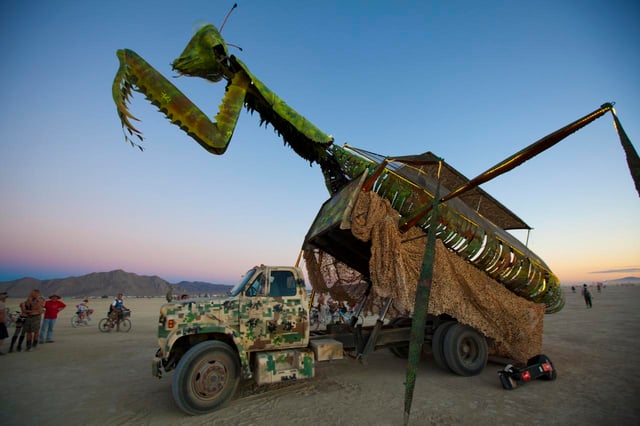
Praying Mantis truck (2010)
Mutant Vehicles, often motorized, are purpose-built or creatively altered cars and trucks.
Participants who wish to bring motorized mutant vehicles must submit their designs in advance to the event's own DMV or "Department of Mutant Vehicles" for approval and for physical inspection at the time of the event.
Not all designs and proposals are accepted.
The event organizers, and in turn the DMV, have set the bar high for what it deems an acceptable MV each year, in effect capping the number of Mutant Vehicles.
This is in response to constraints imposed by the U.S.
Bureau of Land Management, which grants permits to hold the event on federal property, and to participants who want to maintain a pedestrian-friendly environment.
Vehicles that are minimally altered, and/or whose primary function is to transport participants, are discouraged and rejected.
One of the criteria the DMV employs to determine whether an application for a proposed Mutant Vehicle is approved is "can you recognize the base vehicle".
For example, if a 1967 VW van covered with glitter, dolls' heads, and old cooking utensils can still be recognized as a VW van, it is considered to be "decorated not mutated" and is less likely to be approved.
This criterion led to the exclusion of some "Art Cars", which historically have been a staple of the event.
There were over six hundred approved Mutant Vehicles at the event in 2010.
Bicycles

Cyclists at Burning Man (2010)
Bicycles and tricycles are popular for getting around on the dry lake.
Mountain bikes are generally preferred over road bikes for riding on the dried silt, which is normally hard but becomes loose with traffic. Participants often decorate their bikes to make them unique. Since lighting on the bikes is critically important for safety at night, many participants incorporate the lighting into their decorations, using electroluminescent wire (a thin, flexible tube that glows with a neon-like effect when energized with electricity) to create intricate patterns over the frame of the bike. Every night during Burning Man, thousands of bikes and art cars drive around, creating a visual display similar to Las Vegas at night, except that the lights are mobile.
Theme camps
Electronic music
Camps focusing on electronic music, often played by live DJs, began to appear in 1992, as influenced by the rave culture of the San Francisco area. Terbo Ted was identified as having been the first ever DJ in Burning Man history, opening with a Jean Michel Jarre song played off a vinyl record. DJs typically occupied an area on the outskirts of the Playa nicknamed the "Techno Ghetto". In later years, designated spokes of the main camp were designated for "sound camps", with limits on volume and speaker positioning (angled away from the center of Black Rock City). To work around the rules, mutant vehicles with live DJs and large sound systems began to appear as well. A number of major electronic music camps have been well-known recurrents at Burning Man, including Opulent Temple and Robot Heart. Major producers and DJs representing various eras and genres have performed at Burning Man, including Armin van Buuren, Carl Cox, Markus Schulz, François Kevorkian and Freq Nasty among others.[51]
In recent years, concerns began to surface among attendees that a growing number of "mainstream" electronic dance music acts (such as Skrillex and Diplo's Jack Ü in 2014) had begun to appear. In 2015, organizers established a new area known as the "Deep Playa Music Zone" (or DMZ), to serve as a new host for sound trucks featuring live DJs.[51]
Black Rock City
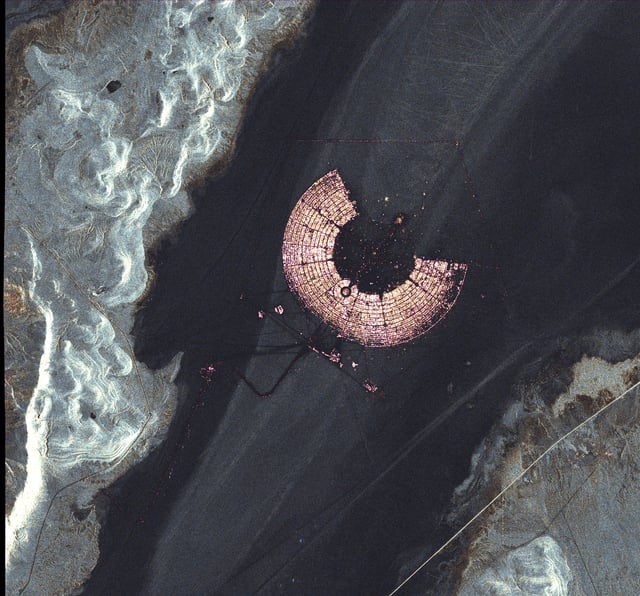
Radar image of Black Rock City taken from the TerraSAR-X satellite in 2011

Aerial views of Black Rock City in 2012
Black Rock City, often abbreviated to BRC, is the name of the temporary city created by Burning Man participants. Much of the layout and general city infrastructure is constructed by Department of Public Works (DPW) volunteers who often reside in Black Rock City for several weeks before and after the event.[167][168] The remainder of the city including theme camps, villages, art installations and individual camping are all created by participants.
City planning

Oblique aerial photo of Black Rock City showing the familiar "C" pattern 2010
The developed part of the city is currently arranged as a series of concentric streets in an arc composing, since 1999, two-thirds of a 1.5-mile (2.4-km) diameter circle with the Man Sculpture and his supporting complex at the very center (40°47′11″N 119°12′24″W [240] in 2017).
Radial streets, sometimes called Avenues, extend from the Man to the outermost circle.
The outlines of these streets are visible on aerial photographs.
The innermost street is named the Esplanade, and the remaining streets are given names to coincide with the overall theme of the burn, and ordered in ways such as alphabetical order or stem to stern, to make them easier to recall. For example, in 1999, for the "Wheel of Time" theme, and again in 2004 for "The Vault of Heaven" theme, the streets were named after the planets of the solar system. The radial streets are usually given a clock designation, for example, 6:00 or 6:15, in which the Man is at the center of the clock face and 12:00 is in the middle of the third of the arc lacking streets (usually at a bearing of 60° true from the Man). These avenues have been identified in other ways, notably in 2002, in accordance with "The Floating World" theme, as the degrees of a compass, for example 175 degrees, and in 2003 as part of the Beyond Belief theme as adjectives ("Rational, Absurd") that caused every intersection with a concentric street (named after concepts of belief such as "Authority, Creed") to form a phrase such as "Absurd Authority" or "Rational Creed". However, these proved unpopular with participants due to difficulty in navigating the city without the familiar clock layout.
The Black Rock City Airport is constructed adjacent to the city, typically on its southern side.
See Transportation section below.[169]
Center Camp
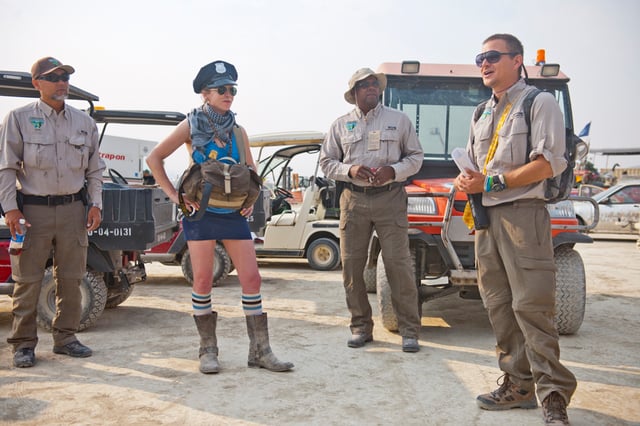
Bureau of Land Management officers and a Ranger at Burning Man
Center Camp is located along the midline of Black Rock City, facing the Man at the 6:00 position on the Esplanade.
This area serves as a central meeting place for the entire city and contains the Center Camp Cafe, Camp Arctica and a number of other city institutions.
Villages and theme camps
Villages and theme camps are located along the innermost streets of Black Rock City, often offering entertainment or services to participants.[170]
Theme camps are usually a collective of people representing themselves under a single identity.
Villages are usually a collection of smaller theme camps which have banded together in order to share resources and vie for better placement.
Theme camps and villages often form to create an atmosphere in Black Rock City that their group envisioned.
As Burning Man grows every year it attracts an even more diverse crowd.
Subcultures form around theme camps at Black Rock City similar to what can be found in other cities.
Volunteers
The Burning Man event is heavily dependent on a large number of volunteers.[171]
Safety, policing and regulations
Black Rock City is patrolled by various local and state law enforcement agencies as well as the Bureau of Land Management Rangers. The local police issue $1,500 fines for drug use and serving alcohol to minors. Burning Man also has its own in-house group of volunteers, the Black Rock Rangers,[172] who act as informal mediators when disputes arise between participants.
Firefighting, emergency medical services (EMS), mental health, and communications support is provided by the volunteer Black Rock City Emergency Services Department (ESD). Three "MASH"-like stations are set up in the city: station 3, 6 and 9. Station 6 is staffed by physicians and nurses working with a contracted state licensed ALS Medical provider, while Stations 3 and 9 are staffed by Black Rock City ESD personnel. While Station 3 and 9 provide emergency services and basic life support, the volunteers are generally doctors, nurses, EMTs/paramedics, and firefighters. Both station 3 and 9 have a small fire engines available in addition to a Hazardous material/ Rescue truck and quick response vehicle for medical emergencies.
In documents from February 2013 first made public on August 29, 2015, it was revealed that in August 2010, the FBI had sent a memo to its field offices in Nevada stating that it would patrol Burning Man to "aid in the prevention of terrorist activities and intelligence collection". Although a threat assessment performed by the FBI in consort with Burning Man's contracted security determined that drug usage and crowd control were the only major threats to Burning Man, the Bureau still sent an unspecified number of undercover officers to the event, with "no adverse threats or reactions".[173]
Black Rock City design evolution
1986–1991
From the very beginning on Baker Beach, to 1991 when Burning Man was set into its desert home, there was no real organizational structure to the city.
According to Rod Garret, designer of Black Rock City, "The original form of the camp was a circle.
This was not particularly planned, but formed instinctively from the traditional campfire circle and the urge to 'circle the wagons' against the nearly boundless space."
This would not work for much longer, as attendance was reaching into the hundreds, and such a large gathering would require some planning.[15][174]
1992–1995
The Bureau of Land Management took notice of the event, and required that plans be drawn up to maintain safety. They also required the Burn to be registered as an official event. In response, four cardinal roads were added emanating from center camp. The Man was located 100 yards (91 m) West of Center camp, due to the camp being oriented with the path of the sun across the sky, as opposed to North-to-South. The center circle from the birth of the event was maintained.
In 1993, the first sound camp was opened.
It was known as the Techno Ghetto, and it was located 2 miles north of Center Camp.
It was not a usual theme camp, but was instead a mini hub on its own; There was a small "center camp" with a message board and Port-a-potties. The center was surrounded by a circle of camping area 1,200 feet (370 m) across. Six massive sound systems faced out from the circle.[175] The Techno Ghetto was placed separately to keep the 'rave' out of the main event, yet as time has progressed, music has become more and more closely tied into the core culture of Burning man, even spawning a unique genre known as Playa Tech.[176]
1996
With the population growing to 8,000 in 1996, more structure was essential to both appease the Bureau of Land Management, and to maintain safety.
A ring around Center Camp, aptly named Ring Road, was added to provide for a second circle of theme camps.
In addition, the eastern section of the circle around Center camp in a cone shape was declared a "No Man's Land", devoid of all art installations and campsites.
The goal was to provide a picturesque view from Center Camp of The Man in the distance.
In addition to the camps circling the Center, there were also camps lining the outside of the No Man's Land cone.
The techno ghetto would remain for one last year in 1996, and it wouldn't return.
Regardless, the spark of music had ignited, and many other sound camps would follow.
1997
In 1997 Burning Man was relocated.
The event moved off of the Playa to the Hualapai Flat, due to political problems with Washoe County. Black Rock City truly became a city in 1997, with formal, labeled streets, zoning, and registration for vehicles and theme camps. Rod Garret was brought on board as the lead designer of Black Rock City from then on.[177] In his design, Center Camp remained the starting point, with two angular arms reaching out on either side to form a shallow "V" shape around the Man. These main arms consisted of six annular roads, and two outlying plazas. 1997 is the first year of a Ranger-patrolled perimeter, and also the first year of one entry gate.
1998
Burning Man returned to the playa in 1998, and the basis of the modern layout was implemented.
The idea was to "recreate some of the intimacy of our original camping circle, but on a much larger civic scale."
Rod Garret's design smoothed out the angular "V" from 1997 and implemented the arc, although in 1998, it stretched less than half-way around the circle.
The radial streets were numbered North 1–20 and South 1–20, instead of the modern clock face system of names such as 11:30 or 5:15.
There were four large plazas, each occupied by a major theme camp.
1999–2010
In 1999, for the Wheel of Time theme, the great arc of the city was expanded to the full 240° (⅔ of a circle) that it is today. The streets were re-numbered to correspond to a clock face, with the Man in the center, Center Camp at 6:00, and streets every 30 minutes (15°) 2:00 through 10:00.
2000 saw the introduction of the Temple as a fixture on the playa, and it has grown to be easily as important as the Man.
It was placed at 12:00 out in the deep playa in the open third of the circle.
2000 also marked the year that the concept of a loud side and a quiet side was replaced by the rule that large scale sound camps would be placed at the 10:00 and 2:00 edges, facing out into the deep playa.[178]
Extra annular streets have been added as need has increased.
2011–present
In 2011, extra radial streets were added from G street out to make outer-city navigation easier.
These streets were added at intervals of fifteen minutes.
Transportation
Road access

'Exodus' from Black Rock City in 2016
Highway 34 provides access to the main entrance to Black Rock City. The highway connects to Highway 447 north of Gerlach, which then runs south to Highway 427 in Wadsworth near Interstate 80.[179]
Vehicles then proceed from the Highway 34 entrance north to the main gate via Gate Road, a desert dirt road with a speed limit of 10 mph.
All vehicles driving into the city must have the appropriate vehicle pass, and all occupants are required to have valid ticket, in order to get in.
Vehicles are also searched for any items that are prohibited in the city.
For those who have their tickets held at Will Call, the booths are located between the Highway 34 entrance and the main gate.
All tickets and vehicle passes must be bought in advance; they are not directly sold outside the gate or at the Will Call booths.[180][181] Furthermore, unless they have a valid early arrival pass for the pre-event set up, any vehicle who arrives before the gate opens is turned away and told to go back to Reno, and not to wait along the side of the road on either Highways 34 or 447 (which would be a safety hazard), nor stay in Gerlach (and overcrowd the small town).[180]
When the Burning Man ends, and the mass exodus out of Black Rock City begins, a road traffic control procedure called "Pulsing" is used to direct vehicles out of the city. At regular intervals (usually an hour during the peak periods), all vehicles are "pulsed" forward all at once for about a mile along Gate Road. This allows vehicles to stop and turn off their engines, while those at southernmost mile of the multi-lane Gate Road slowly merge and then turn onto the two-lane Highway 34.[182]
Commercial airports
The airport with regular commercial service closest to the event is the Reno-Tahoe International Airport in Reno, Nevada, over two hours' drive away. An airport spokesperson said in 2009 that 15,000 burners arrive to the event via the airport annually, making it the second-busiest time for them. In 2008 and 2009, an information desk for burners was organized in Reno airport.
San Francisco International Airport, nearly six hours away by car, is the nearest airport with a high volume of international service. Other prominent, albeit with less international passenger traffic and more domestic services are Sacramento International Airport, which is 4.5 hour drive from Black Rock City, as well as other Bay Area airports such as Oakland International Airport, and San Jose International Airport.
Salt Lake City International Airport, serving Salt Lake City, Utah and McCarran International Airport, serving Las Vegas Nevada, are both a respective 8.5 hour drive to Black Rock City.
Temporary airstrip
A section of the Playa is used for a non-permanent airport, which is set up before each event and completely erased afterward.[183] It serves both general aviation and charter flights.
Pilots began camping there about 1995, and once compelled to add structure, it was established in a form acceptable to the BLM in 1999 through the efforts of Tiger Tiger (Lissa Shoun) and LLC board member Mr. Klean (Will Roger).
In 2009 it was recognized by the FAA as a private airport and designated 88NV.
It is found on the Klamath Falls Sectional, using a CTAF of 122.9 MHz. Black Rock UNICOM and the airport are operational on that frequency from 6:00 am to 7:30 pm PDT each day during the event. The runway is simply a compacted strip of playa, and is not lighted.[184] Because of the unique air traffic and safety issues associated with the airport, pilots are strongly encouraged to familiarize themselves with published information and procedures provided by, for example, AOPA. Because of the changes of the surface each year, information about the airport is subject to change.[185]
Shuttles
There are prepaid shuttles, originating in Reno and San Francisco, that move participants to and from the event.
During the event there is also a paid shuttle between the event and the nearby towns of Gerlach and Empire.
Exiting and reentering the event requires an additional fee, and is highly discouraged.
Other
Participants also share rides[186] and hitchhike.
"Leave No Trace" policy

A collection of MOOP (Matter Out of Place), 2013
Burning Man takes place in the middle of a large playa, and while not inhabited by humans itself, the area around the playa is home to many animals and plants.[187] Supporters of Burning Man point out that participants are encouraged to leave no trace (LNT) of their visit to Black Rock City (BRC) and not to contaminate the area with litter, commonly known as MOOP (Matter Out of Place). Despite the BLM and LLC's insistence on the practice of LNT, the amount of residual trash at the site has increased over the years,
[t]he number of items per plot in the City consistently increased over the 2006 to 2009...
Although the observed trend was not statistically significant, regression analysis indicated that the predicted trend explained over 97% of the variance in the data.[188]
While fire is a primary component of many art exhibits and events, materials must be burned on a burn platform.[29] From 1990 through 1999, burning was allowed to take place directly on the surface of the playa, but this left burn scars (fired pinkish clay-like playa surface).
When it was finally determined that they did not dissipate with the annual winter rains and flooding, in 2000, the organization declared that fires had to be elevated from the playa surface for its protection.
When it was discovered by two of the founders of the Friends of Black Rock / High Rock (Garth Elliott & Sue Weeks) and BLM Winnemucca district director Terry Reid that Burn scars from prior sites (numbering 250) still remained, they were finally eradicated in 2000 by the DPW clean up crew headed by Dan Miller.
Even gray water is not to be dumped on the playa, and used shower water must be captured and either evaporated off, or collected and carried home with each participant or disposed of by roving septic-pumping trucks, which also service RVs. Methods used for evaporating water normally include a plastic sheet with a wood frame.
The Bureau of Land Management, which maintains the desert, has very strict requirements for the event. These stipulations include trash cleanup, removal of burn scars, dust abatement, and capture of fluid drippings from participant vehicles. For four weeks after the event has ended, the Black Rock City Department of Public Works (BRC – DPW) Playa Restoration Crew remains in the desert, cleaning up after the temporary city in an effort to make sure that no evidence of the event remains.[191]
Criticism
Negative effects on the environment
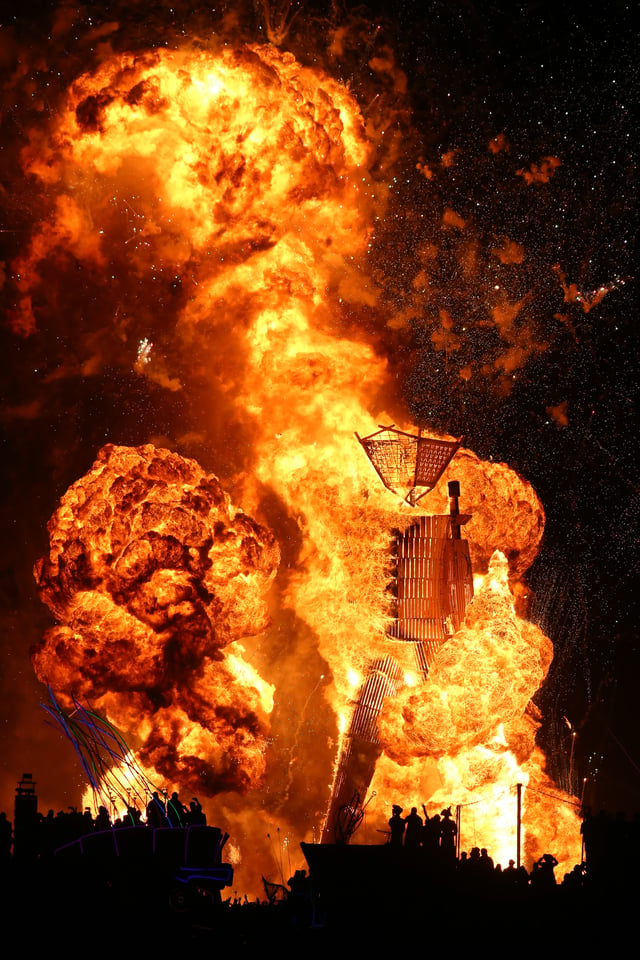
The man burns at Burning Man 2014
Burning Man's carbon footprint is primarily from transportation to the remote area.
The CoolingMan organization has estimated that the 2006 Burning Man was responsible for the generation of 27,000 tons of carbon dioxide, with 87% being from transportation to and from the remote location.[192] The Sierra Club has criticized Burning Man for the "hundreds of thousands" of plastic water bottles that end up in landfills, as well as ostentatious displays of flames and explosions.[193]
In an attempt to offset some of the event's carbon footprint, 30- and 50-kilowatt solar arrays were constructed in 2007 as permanent artifacts, providing an estimated annual carbon offset of 559 tons.[131] The Burn Clean Project is a volunteer organization that has helped replace the use of fossil fuel with biodiesel.
Gentrification
Burning Man has attracted a number of billionaires and celebrities, many of them from Silicon Valley and Hollywood.[197] It has become a networking event for them,[198] with Tesla Motors CEO Elon Musk once stating that Burning Man "is Silicon Valley".[197]
These billionaires have paid for more luxurious camps to be set up in recent years.
Derisively nicknamed "plug-n-play" or "turnkey" camps, they in general consist of lavish RV's and luxury restroom trailers that are driven into the city and connected together to form de facto gated areas. These billionaires then fly in to the airport on private planes, are driven to their camps, served by hired help (nicknamed "sherpas"), and sleep in air-conditioned beds.[197] One venture capitalist billionaire threw a $16,500-per-head party at his camp.[199] In 2017, Google employees shipped a box of lobsters to the playa for a meal.[200]
Despite allowing the rich to participate in Burning Man per the "radical inclusion" principle, many traditional Burners have spoken out against their exclusive practices.[201] Larry Harvey wrote that they also conflict with the "radical self-reliance" and other principles,[202] but has also stated that permitting the wealthy to attend is still beneficial for Burning Man.[203] Vandalism that occurred at the White Ocean sound camp in 2016 was said to have been a "revolution" against these attendees, describing them as being a "parasite class" or "rich parasites".[201][204][205]
Meanwhile, the regular admission price has increased over the years.
In addition, Nevada lawmakers have modified the state's entertainment and sales tax code to include such nonprofit organizations like Burning Man that sell more than 15,000 tickets.
As a result, an individual ticket (including taxes) cost $424 in 2016.
Even tickets sold under Burning Man's low income program are subject to these taxes.[206] Including transportation, food, camp fees, clothing and costumes, and gifts, CNBC estimated in 2016 that the total cost of attending could range from $1,300 up to $20,000.[207] In 2017, Money magazine estimated an average total cost of $2,348 to attend.[208]
According to the racial makeup of Burning Man attendees in 2014, 87% of them identified themselves as white, 6% as Hispanic / Latino, 6% as Asian, 2% as Native American, and 1% as black (figures rounded).
When interviewed by The Guardian about these figures, Harvey replied, "I don't think black folks like to camp as much as white folks... We're not going to set racial quotas... This has never been, imagined by us, as a utopian society."[209]
Photography restrictions

Video of the 'man' sculpture burning in 2011
The terms of the Burning Man ticket require that participants wishing to use photo and video-recording equipment share a joint copyright of their images of Black Rock City with Burning Man, and forbid them from using their images for commercial purposes.
This has been criticized by many, including the Electronic Frontier Foundation (EFF).[210][211]
A Burning Man spokeswoman replied that the policies are not new, were written by a former head of the EFF, were used when suing to block pornographic videos, and ultimately arose from participant concerns: "We're proud that Black Rock City (a private event held on public land) is widely acknowledged as a bastion of creative freedom.
[B]ut that protection [of participants' freedoms] does necessitate the acceptance of some general terms of engagement when it comes to cameras... EFF seems to think that anyone attending any event somehow has an absolute right to take photographs, and then to do whatever they want with those images without any effective restriction or manner of enforcement.
While we believe that such rights do make sense for any of us taking pictures in purely public spaces, this is not true in the private space of Burning Man – if it were it would mean that Burning Man couldn't protect participant privacy or prevent commercialization of imagery."[212]
The Burning Man organization has since worked with the EFF and with Creative Commons and other parties, and has revised and clarified the photography policies.[213]
Regional events

A camp at a regional burn in South Africa
The popularity of Burning Man has encouraged other groups and organizations to hold events similar to Burning Man.
Burners have created smaller regional events modeled on Burning Man, such as Burning Flipside in Texas; Apogaea in Colorado; Playa del Fuego in Delaware; Firefly in New England; Kiwiburn in New Zealand; Burning Seed in Australia; Transformus in North Carolina; AfrikaBurn in South Africa; NoWhere near Zaragoza in Spain; Midburn in Israel; and many others.[214]
Some of the events are officially affiliated with the Burning Man organization via the Burning Man Regional Network.[215] This official affiliation usually requires the event to conform to the 10 principles and certain standards outlined by the Burning Man organization and to be accompanied by a "Burning Man Regional Contact", a volunteer with an official relationship to the Burning Man Project via a legal Letter of Agreement.
In exchange for conforming to these standards, the event is granted permission to officially communicate itself as a Burning Man Regional Event.
Also, the regional event organizers are enabled to exchange best practices with each other on a global level via online platforms and in-person conferences, which are partly sponsored by the Burning Man Project.
In popular culture
The South Park episode "Coon vs. Coon and Friends" features Cartman manipulating the Dark Lord Cthulhu to do his bidding, which includes destroying Burning Man.[216]
Cory Doctorow's 2013 novel Homeland opens at a near-future Burning Man.[217]
The 2016 video game Watch Dogs 2 features the characters visiting a Burning Man-themed event.[218]
The Simpsons episode "Blazed and Confused" features "Blazing Guy", an event based on Burning Man, with one character even referencing "Burning Man" before correcting herself to "Blazing Guy".[219]
The first Google Doodle, a playful adaptation of the Google logo, announced the founders' attendance at Burning Man in 1998.[220][221]
The entire plot of the Malcolm in the Middle episode "Burning Man" unsurprisingly centers on Burning Man.[222]
The Xavier: Renegade Angel episode "Escape from Squatopian Freedom" features protagonist Xavier going to an event known as "Burning Person".[223]
The 2017 film The Girl from the Song was filmed at the 2015 Burning Man.
Films
Dust & Illusions
Taking My Parents to Burning Man
Spark: A Burning Man Story
Winds of Change [224]
See also
Festival gatherings Böögg Holika Dahan Lohri Rainbow Gathering St John's Eve Vijayadashami
Music festivals Fusion Festival Transformational festival Boom Festival Ozora Festival Psy-Fi
Places Arcosanti Auroville Temporary Autonomous Zone
Others Wicker man